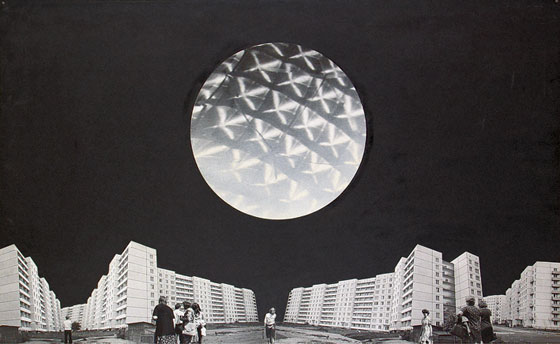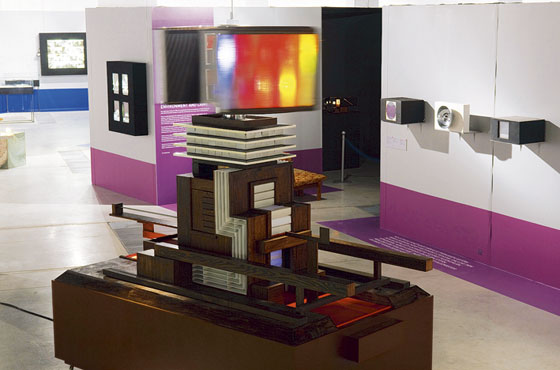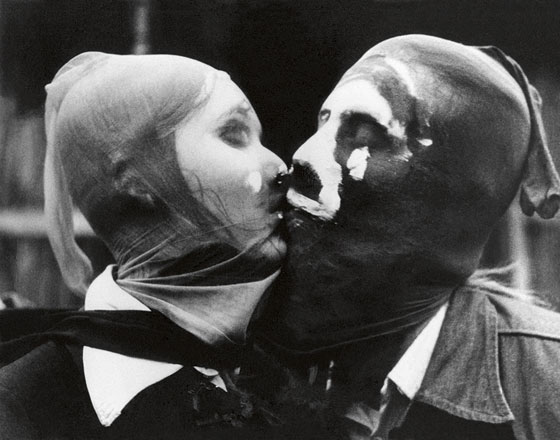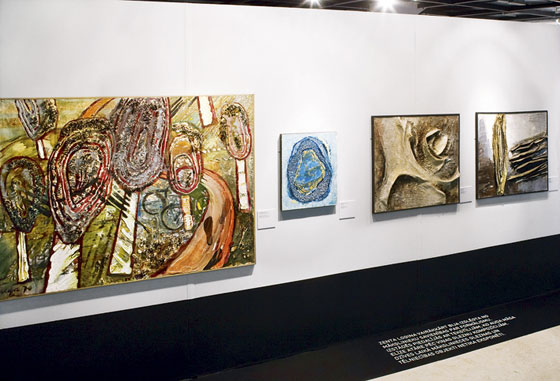|
|
| Results of the revision Alise Tīfentāle, Art Historian AND OTHERS – Movements, Explorations and Artists in Latvia 1960–1984 17.11.–30.12.2010. Riga Art Space | |
 Valdis Celms. Architectural proposal Kinetic light object 'Baloon'. 1978. Collection of Latvian Artists' Union | |
| A revisionist view of the recent past has become topical, and it could be said that we are experiencing a miniature renaissance. Only instead of antique culture we are once again turning to the relatively recent Soviet period. The development of this renaissance at the beginning of the 21st century in Latvia was marked by a number of large-scale events and publications, which have formed an indispensable background to the AND OTHERS exhibition. The earliest harbinger of this revision of cultural heritage was in 1993, when the cultural historical exposition The Goat Climbed up into the Sky was opened at the Literature and Art History Museum. It is significant that at that time it was specifically the “informals”, the phenomenon of alternative culture and the meeting place of 1960s young artists and intellectuals (that is, Kaza [or ‘Goat’, a cafe in Old Riga]) that became the focus of public attention. The exhibitions thereafter have focused mainly on a reassessment of established values, staying away from risky “otherness” and informalism. As one of the first significant events at the beginning of the 21st century, the exhibition featuring the Artists’ Union of Latvia collection of paintings Witnesses of an Age (National Museum of Art, 26 April–9 June 2002), and the book that accompanied it, Artists’ Union of Latvia. Art Collection. Painting. Witnesses of an Age. The 1960s, 1970s and 1980s, must be mentioned. This was followed by a homage to the 20th anniversary of the 1984 show Nature. Environment. Man – the Nature. Environment. Man. 2004 (National Museum of Art, Arsenāls exhibition hall, 16 April–16 May 2004) exhibition and collection of writings compiled by curator Inese Baranovska. The next event in this series was the Mythology of Sovietland (Latvian National Museum of Art, Arsenāls exhibition hall, 11 April–7 September 2008) exhibition created by curator Elita Ansone. A short time before the AND OTHERS exhibition, the quantitatively extensive exhibition Painting in Latvia 1950–1990 from the Artists’ Union of Latvia Collection (20 May–15 August 2010) created by curator Inga Šteimane could be viewed at the Riga Art Space. At the same time as AND OTHERS, one could view in Riga curator Ieva Zībārte’s very meticulously created exhibition (Contemporary Art Centre kim?, 5 November–19 December 2010) dedicated to the architect Marta Staņa Behind the Curtain. A certain context for the field of design, which was also touched on by the creators of AND OTHERS, was provided by Provocation (Museum of Decorative Arts and Design, 11 November–30 December 2010), an exhibition dedicated to the centenary of designer Ādolfs Irbīte. In the first decade of the 21st century a number of significant publications were brought out which, from a variety of viewpoints but in an equally analytical and argumented manner, examined the specifics of the cultural heritage of the Soviet period and its problematical evaluation. The work by American art historian Mark Allen Svede must be noted as the most fundamental contribution at international level to the broadening of understanding of Latvian Soviet period art. Even though it’s not always possible to agree with Svede’s views, his articles in the collections of writings Style and Socialism. Modernity and Material Culture in Post-War Eastern Europe (2000)1, Art of the Baltics. The Struggle for Freedom of Artistic Expression under the Soviets, 1945–1991 (2002)2 and Beyond Memory. Soviet Nonconformist Photography and Photo-Related Works of Art (2004)3 have brought in new trends to local art theory, promoting the recognition and exploration of alternative (in all the various meanings of the word) art directions. | |
 View from the exhibition AND OTHERS... Movement, environment and light exposition. Foreground: Kinetic sculpture The Lighthouse. 1977-1985. The Latvian Centre for Contemporary Art database | |
| Of the publications issued in Latvia, in turn, ‘Here’s to Music, Beautiful and Melodious: Soviet Cultural Policy, 1932–1964’ by Sergejs Kruks (Neputns, 2008), Inga Pērkone’s ‘To love is all I can do... the Image of Woman in Latvian Film’ (Neputns, 2008), as well as ‘USSR Political Censorship in Latvia 1940–1990’ by Heinrihs Strods (Jumava, 2010) should be mentioned. The book ‘Observer: About the Trial of Artist Jurģis Skulme’ by Andris Grūtups (Atēna, 2009) also refers in its own way to the group of issues in question. Monographs about artists, architects and photographers whose creative work was realised for the main part within the Soviet period also have a role in the renaisance. An interest in alternative culture under Soviet conditions was affirmed by the book ‘The Unclassifiables: Alternative Culture in Latvia, XX century. The 60s and 70s of the 20th Century’ (Compiled by E. Valpēters. Riga: Latvijas Vēstnesis, 2010)4. At the same time, there is still no basis to assume that the material from the Soviet period has been wholly investigated, structured and analytically examined. Quite the contrary, fragmentary publications and expositions do not provide a clear and understandable overview. Opinions and interpretations range from “aesthetic cynicism” to solipsism and mystification. The exhibition AND OTHERS expressed the goal of showing those “movements, explorations and artists” who had not yet featured in the contents of exhibitions presented up till now. As Anita Vanaga writes in the exhibition catalogue, “the exhibition AND OTHERS inspects the period of time between 1960 and 1984, hoping to put a finger on some undervalued phenomenon that has stayed under the radar, unnoticed, or hoping at least to find unnoticed connections between known things.”5 The Official and the Others However, in order to say who those “others” are, one must clearly know who the rest were. According to the catalogue text, this could be “the official artistic canon”6 or “conventional forms of official realism”7, but not always. This gives foundation for a theoretical discussion, because, so it seems, as yet art historians have not been able to agree on clear criteria that could characterise “official art” in Latvia during the period of Soviet rule. The curator of the AND OTHERS exhibition, Vilnis Vējš, points out that “to describe the art against which AND OTHERS should be positioned was not the aim of the exhibition. (..) To a certain degree the exhibition must define two things at once, but still focus on the second. Visually, the first could be seen at the retrospective exhibitions held by the Artists’ Union and the Museum.”8 However, the works shown at the exhibitions mentioned are very diverse, both thematically as well as in their formal means of expression. It is not possible to refer to Socialist Realism principles, and to try to attribute them to all “official” Soviet period art (purchased for collections, exhibited, reproduced in ‘Māksla’ [an art magazine] etc.). The unclear boundaries of the ‘canon’ of Socialist Realism have also been remarked upon by curator Vējš9 and the exhibition’s curator of the painting and graphic art section, Irēna Bužinska: “...a number of parallel or even opposing artistic trends developed alongside or outside Socialist Realism, which was in itself increasingly hard to define. It would be more useful to view this period in art as a simultaneously existing, multi-layered body of stylistic trends.”10 As the traits which help to separate the “others” from those that aren’t like that, the catalogue cites “officially prohibited imagery”11, “separateness and isolation”12, “status of a freethinker” and “a deliberate detachment”13, “aesthetic principles that differed significantly from the mainstream”14, “activities [that] were not only and official, they could also become illegal”15. | |
 Andris Grīnbergs. Terrorists. 1974 | |
| It is clear that the question of the boundary between “official” and “other” art is not to be addressed by examining art works which weren’t programmed into the Soviet art institution hierarchy at all (for example, the performances and actions in the ‘Improvisations, actions and performances’ section created by Māra Traumane) or even those that had been assigned amateur artistic performance status in the Soviet system (for example, the ‘Riga Pantomime’ at the centre of the performing arts section curated by Viļnis Vējš, which developed from a Builders’ Cultural House drama ensemble, or the amateur status of fine art photography in the ‘Parallel currents in photography’ section created by Līga Lindenbauma). Meanwhile kinetic art (in the section ‘Movement, environment and light’, curator Ieva Astahovska) during the Soviet period was consigned to the field of the applied arts. This was the first time that these types of works were being exhibited in an art exhibition in Latvia, and this can be looked upon as the greatest achievement of the AND OTHERS exhibition. From the essays in the exhibition catalogue one can distil frequently mutually exclusive criteria for choosing works for the exhibition, and this points to challenges yet to be addresssed in the interpretation of Latvian art from the Soviet period. “State Purchasing Policy”, or the rejection of specific works or broader formal or aesthetic trends during the purchasing process As pointed out by Vilnis Vējš, “a comparison of art commissioned and purchased by the state and works kept in studios, attics and under beds starkly reveals the difference between art works favoured by the regime and others”16. Not always works favoured by the regime can be so easily separated from those more awkward, i.e. not in favour, as works created in an author’s signature style or within the framework of an artistic direction can often be found both in official collections as well as an author’s private ownership. As regards these kinds of situations, Vējš points out that in the process of research it was concluded that stylistically “the most striking works really have remained the possession of the artist or in private collections”17, and so it is assumed that purchasing policy determined the selection of more “moderate” works. In addition to a range of works in the exhibition which were indicated to have been outside any kind of artistic circulation, or had been banned, rejected, not purchased and so on, there are also some that have been recognized – they have either been exhibited or even introduced into the urban environment. For example, the light kinetic object, the Riga Central Railway Station clock tower (Jānis Krievs, 1980), or the Sakta kinetic object for the Hotel Latvija facade (Artūrs Riņķis, 1978)18. Vējš does, however, emphasize that in the case of these two works and “none of the exhibited works – scale models, sketches etc. have been purchased for state collections and none have been paid for, otherwise they wouldn’t be in the possession of the authors, and therefore these cannot considered as commissioned works in the literal sense.”19 In the kinetic art section ‘Movement, environment and light’, curator Ieva Astahovska states that the works mentioned “were accepted by the institutions and enjoyed much more publicity”20. In reply to a question about the principles for the selection of works, Astahovska comments that “in its own way this section is different from the rest, as these works weren’t unofficial, private, rejected or art which was placed in the amateur category (namely, it was official, public, accepted, professional art), but at the same time parallels with other fields appear – their interdisciplinary nature and location in a non-defined “twilight zone” (at a time when the division into sectors of genre and art fields was crucial), as well as art synthesis. The majority of the works included in this section came into being on the initiative of the artists themselves, and not because of state commissions. Also, kinetic art was not accepted as being of equal worth to the fine arts – formally it was categorized as design, which in actual fact it wasn’t. It brought about discussions on what then art actually is and what its boundaries are.”21 Stylistic trends The curator of the wide-ranging and ably created painting section, Irēna Bužinska, mentions directions22 which are connected with abstractionism and assemblage, the influence of surrealism, a broader interpretation of realism and the beginnings of photorealism and postmodernism as being the “others”. If one can agree that “other” works are, for example, assemblages by Visvaldis Ziediņš and Romualds Geikins, or Zenta Logina’s abstract paintings (which I can remember having seen reproduced in the dying stages of the Soviet period in the late 1980s – not in an art publication, however, but in the ‘Nature and History Calendar’), then it is debatable whether photorealism, for instance, is a movement in painting which can be tagged with the label of ‘otherness’. The works of Miervaldis Polis, Līga Purmale, Brando Vasiļevskis and Imants Lancmanis, belonging to this style, were exhibited and known to those who were interested in art. Besides, in contradiction to the previous criterion, paintings in photorealism style by those same artists were also purchased for official collections. On the other hand, the works by the Russian artist community, which have also been exhibited for the first time, undoubtedly represent the “other” direction. They really do “broaden the view of Latvia’s art landscape, enriching the understanding of it,” and also stimulate us to examine the question of whether surrealism did exist in Latvia.23 | |
 View from the exhibition AND OTHERS... Painting and graphic art exposition. The Latvian Centre for Contemporary Art database | |
| The problematics of stylistic and aesthetic criteria become evident in the ‘Parallel currents in photography’ section. The section’s curator, Līga Lindenbauma, has indicated in the catalogue that “because the exhibition is dedicated to highlighting artistic trends that differed from the official or generally accepted aesthetic, only photographic phenomena which demonstrated aesthetic principles that differed significantly from the mainstream (..) are included”.24 However, this is not easy to identify in the works exhibited, mainly because there is an absence of guidelines as regards the telltale signs of “official” photo art. Even though Lindenbauma has pointed out that “in art photography the photo image’s conformity with the existing conditions on content and composition25 in the traditional art genres was important”, this assertion can be all too easily disputed, as it is not substantiated with a concrete body of photographic works (just what exactly is the “the official or generally accepted aesthetic” mentioned by the curator?). I cannot agree with the assertion that documentarism as such was a “marginal exploration” in Latvian fine art photography in the period from 1960 to 1984. Similarly the motivation for including works by the Latvian photo art classicist Gunārs Binde in the exhibition is unclear, as they were very popular, positively regarded and formed part of the aesthetic canon of photographic art. For that matter, the inclusion of examples of abstract photography were justified (the crystallographic works of Valters Jānis Ezeriņš), but one was left wishing for a broader exploration of the motifs and influences of surrealism. A more comprehensive view of research on the problematic situation in fine art photography can be obtained from Līga Lindenbauma’s essay in the December 2010 issue of the Foto Kvartāls magazine26. Institutional criteria Vilnis Vējš reminds us that “in the stagnation years, the tightly controlled system discriminated not only against specific individuals but against entire artistic forms by denying them the status of a professional art form or giving them a low place in the hierarchy”.27 Isolation from professional art and being bestowed the much lower artistic amateur status as a criterion of “otherness” was ascribed, for example, to the ‘Riga Pantomime’ ensemble’s activities, in the performing arts section. The activities in the field of cinema by the experimental ‘Office’ group and the entire exhibition section curated by Māra Traumane ‘Improvisations, stagings, performances’ stood even further away from the institutional framework. The most shining success of the latter is that all the documentation regarding the performances by artist Andris Grīnbergs28 has been collated for the first time, as well as a similarly detailed survey of the activities of Hardijs Lediņš, Juris Boiko and the NSRD. This art “remained outside of the ideologically controlled sphere of art, not fitting either the strictures imposed on professional and amateur art or the boundaries framing the lifestyle of a Soviet individual”29. On the other hand, for example, by exhibiting in the painting section works by graduates of the Latvian SSR Academy of Art and the LSSR Artists’ Union members, works that were accepted by the system, the institutional criterion is no longer in force. The “otherness” of these works is hidden, for example, in the stylistic nuance of a particular work. The institutional division is not the determining factor in the ‘Movement, environment and light” section also. As its curator Astahovska comments, “the otherness criteria is based more on the thinking and perception meaning and not the institutional – the movement outside defined phenomena, an experimental approach, inter-disciplinary, as well as the marking of a change in the perception of art: an art work is not a “painting”, a “graphic”, a “sculpture’, but, for example, an “object” (the journey to the “installation”) or the “environment” as a whole, the “process” as well and the “reaction of the viewer” – many criteria, which were much closer to Western post war (neo)avant-garde, than local official art criteria.”30 The impression of the exposition as an enjoyable and at the same time educational journey was ensured by the well thought-out and logical way the material had been arranged, the quantity of commentary and the laconic, easily navigable environment (exhibition artist Anna Heinrihsone). The AND OTHERS exhibition marked an important turning point in the attitude towards art created in the Soviet era, substantially broadening the field of investigation. Many more new discoveries can be expected, as well as a wide range of theoretical questions which should be worthwhile discussing in an academic environment. However, this introduction convinces: for the first time works, events and directions which up until now had been virtually forgotten have been collated, structured and brought back to the fold into the history of art. /Translator into English: Uldis Brūns/ 1 Svede, Mark Allen. All You Need is Lovebeads: Latvia’s Hippies Undress for Success. In: Reid,. S.E., Crowley, D. (eds.) Style and Socialism. Modernity and Material Culture in Post-War Eastern Europe. Oxford: Berg, 2000, pp. 189–208. 2 Svede, Mark Allen. Many Easels, Some Abandoned. Latvian Art after Socialist Realism. In: Dodge, N.T. Rosenfeld, A. (general eds.) Art of the Baltics. The Struggle for Freedom of Artistic Expression under the Soviets, 1945–1991. New Brunswick, New Jersey and London: Rutgers University Press, 2002, pp. 185–274. 3 Svede, Mark Allen. On the Verge of Snapping: Latvian Nonconformist Artists and Photography. In: Neumaier, D. (general ed.) Beyond Memory. Soviet Nonconformist Photography and Photo-Related Works of Art. New Brunswick, New Jersey, and London: The Jane Voorhees Zimmerli Art Museum and Rutgers University Press, 2004, pp. 229–246. 4 The Latvian National Library index system also shows the following as keywords connected with this book: counter-culture, subculture, hippies, boheme, intellectuals. 5 Vanaga, Anita. “Lesson 3. Default Setting”. In: AND OTHERS. Movements, Explorations and Artists in Latvia 1960–1984. [Catalogue] Ed. by V. Vējš. Riga: Contemporary Art Centre, 2010, p. 29. 6 Vējš, Vilnis. “Lesson 1. Performing Arts”. AND OTHERS.., p. 25. 7 Bužinska, Irēna. “Lesson 2. Painting and Graphics”. AND OTHERS.., p.26. 8 Vilnis Vējš e-mail letter to the author of the essay on 11th December 2010. 9 Vējš, Vilnis. [Introduction] AND OTHERS.., p. 24. 10 Bužinska, Irēna. “Lesson 2. Painting and Graphics”. AND OTHERS.., p. 26. 11 Vējš, Vilnis. “Lesson 1. Performing Arts”. AND OTHERS.., p. 25 12 Bužinska, Irēna. “Lesson 2. Painting and Graphics”. AND OTHERS.., p. 26. 13 Vanaga, Anita. “Lesson 3. Default Setting”. AND OTHERS.., p. 29. 14 Lindenbauma, Līga. “Lesson 5. Parallel Currents in Photography”. AND OTHERS.., p. 33. 15 Traumane, Māra. “Lesson 6. Improvisations, Stagings, Performances”. AND OTHERS.., p. 34. 16 Vējš, Vilnis. [Introduction] AND OTHERS.., p. 24. 17 Vilnis Vējš e-mail letter to the author of the essay on 11th December 2010. 18 Vilnis Vējš e-mail letter to the author of the essay on 11th December 2010. 19 Vilnis Vējš e-mail letter to the author of the essay on 11th December 2010. 20 Astahovska, Ieva. “Lesson 4. Movement, Environment and Light”. AND OTHERS.., p. 30. 21 Ieva Astahovska’s e-mail letter to the author of the essay on 12th December 2010. 22 I. Bužinska has pointed out that the mentioned art directions in Latvia’s art cannot be encountered in a “pure” form, i.e. as we know them from Western art history. It would be more accurate to speak of the specifics of these and other directions in the “hybrids and mutations” determined by local conditions. Irēna Bužinska’s telephone discussion to the author of the essay on 14th December 2010. Recording of the conversation in the author’s archive. 23 Irēna Bužinska’s telephone discussion to the author of the essay on 14th December 2010. Recording of the conversation in the author’s archive. 24 Lindenbauma, Līga. “Lesson 5. Parallel Currents in Photography”. AND OTHERS.., p. 33. 25 Līga Lindenbauma’s e-mail letter to the author of the essay on 13th December 2010. 26 Lindenbauma, Līga. Parallel Currents in Latvia’s Photography 1960–1980. Foto Kvartāls, No. 6 (26), 2010, pp. 6–14. 27 Vējš, Vilnis. “Lesson 1. Performing Arts”. AND OTHERS.., p. 25. 28 The documentation highlighted a new theoretical problem in art interpretation developed during the Soviet period. A number of Andris Grīnbergs’ performance / happening documentation photographs were, up till now, known as the photographer’s works (for example, Jānis Kreicbergs’ photographs), and the curator’s theoretically founded choice to show, in the context of the exposition, the performance author rather than the photographer, as the main author reveals a new aspect. M. Traumane points out that these works “were in the Soviet period considered as Kreicbergs’ photos, but as Grīnbergs’ performances – eventually banned”. Māra Traumane’s e-mail letter to the author of the essay, 12th December 2010. 29 Traumane, Māra. “Lesson 6. Improvisations, Stagings, Performances”. AND OTHERS.., p. 34. 30 Ieva Astahovska’s e-mail letter to the author of the essay on 12th December 2010. | |
| go back | |







